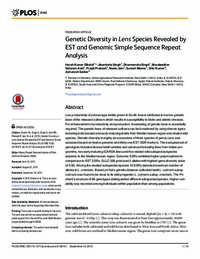Genetic Diversity in Lens Species Revealed by EST and Genomic Simple Sequence Repeat Analysis

Authors:
Low productivity of pilosae type lentils grown in South Asia is attributed to narrow genetic
base of the released cultivars which results in susceptibility to biotic and abiotic stresses.
For enhancement of productivity and production, broadening of genetic base is essentially
required. The genetic base of released cultivars can be broadened by using diverse types
including bold seeded and early maturing lentils from Mediterranean region and related wild
species. Genetic diversity in eighty six accessions of three species of genus Lens was
assessed based on twelve genomic and thirty one EST-SSR markers. The evaluated set of
genotypes included diverse lentil varieties and advanced breeding lines from Indian programme,
two early maturing ICARDA lines and five related wild subspecies/species
endemic to the Mediterranean region. Genomic SSRs exhibited higher polymorphism in
comparison to EST SSRs. GLLC 598 produced 5 alleles with highest gene diversity value
of 0.80. Among the studied subspecies/species 43 SSRs detected maximum number of
alleles in L. orientalis. Based on Nei’s genetic distance cultivated lentil L. culinaris subsp.
culinaris was found to be close to its wild progenitor L. culinaris subsp. orientalis. The Prichard’s
structure of 86 genotypes distinguished different subspecies/species. Higher variability
was recorded among individuals within population than among populations.
